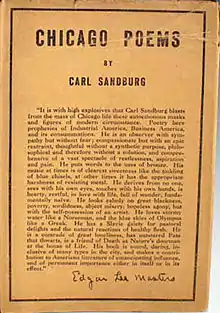Abraham Lincoln: The War Years
Abraham Lincoln: The War Years encompasses volumes three to six of a six-volume biography of Abraham Lincoln by Carl Sandburg; these volumes focus particularly on the American Civil War period. The first two volumes, published in 1926, cover Lincoln's birth through his inauguration as president. The final four volumes were published together in 1939, and won the 1940 Pulitzer Prize for History.[1][2][3]
 First editions | |
| Author | Carl Sandburg |
|---|---|
| Country | United States |
| Language | English |
| Genre | Non-fiction |
| Publisher | Harcourt Brace |
Publication date | 1939 |
Abraham Lincoln: The Prairie Years, 2 vols. (1926) and Abraham Lincoln: The War Years, 4 vols. (1939) are collectively "the best-selling, most widely read, and most influential book[s] about Lincoln."[4] The books have been through many editions, including a one-volume edition in 1954 prepared by Sandburg.
Sandburg's Lincoln scholarship, primarily in these volumes, had an enormous impact on the popular view of Lincoln. The books were adapted by Robert Sherwood for his Pulitzer Prize-winning play Abe Lincoln in Illinois (1938) and David Wolper's six-part dramatization for television, Sandburg's Lincoln (1974). He recorded excerpts from the biography and some of Lincoln's speeches for Caedmon Records in New York City in May 1957. He was awarded a Grammy Award in 1959 for Best Performance – Documentary Or Spoken Word (Other Than Comedy) for his recording of Aaron Copland's Lincoln Portrait with the New York Philharmonic. Some historians suggest more Americans learned about Lincoln from Sandburg than from any other source.[5]
The books garnered critical praise and attention for Sandburg, including the 1940 Pulitzer Prize for History for the four-volume The War Years. But Sandburg's works on Lincoln also brought substantial criticism. William E. Barton, who had published a Lincoln biography in 1925, wrote that Sandburg's book "is not history, is not even biography" because of its lack of original research and uncritical use of evidence, but Barton nevertheless thought it was "real literature and a delightful and important contribution to the ever-lengthening shelf of really good books about Lincoln."[6] Others criticized Sandburg's failure to document sources and factual errors.[4] Others complain The Prairie Years and The War Years contain too much material that is neither biography nor history and is instead "sentimental poeticizing" by Sandburg.[4] Sandburg may have viewed his book as an American epic more than as a mere biography, a view mirrored by other reviewers as well.[4]
References
- Elizabeth A. Brennan; Elizabeth C. Clarage (1999). Who's who of Pulitzer Prize Winners. Greenwood Publishing Group. pp. 290–. ISBN 978-1-57356-111-2.
- Gabor Boritt Robert C. Fluhrer Professor of Civil War Studies and Director of the Civil War Institute Gettysburg College (8 February 2001). The Lincoln Enigma : The Changing Faces of an American Icon: The Changing Faces of an American Icon. Oxford University Press. pp. 196–. ISBN 978-0-19-803302-8.
- "1940 Pulitzer Prize Winners". www.pulitzer.org. Retrieved 25 August 2014.
- Hurt, James (Winter 1999). "Sandburg's Lincoln within History". Journal of the Abraham Lincoln Association. 20 (1): 55–65.
- Penelope Niven, Carl Sandburg: A Biography (New York: Scribner's, 1991), 536.
- William E. Barton, "Review of The Prairie Years," American Historical Review 31 (July 1926): 809–11
